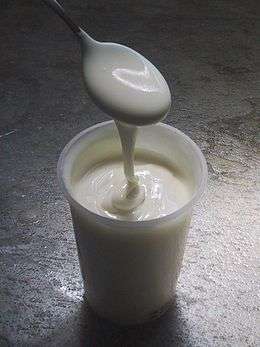Requeijão
Requeijão (Portuguese pronunciation: [ʁekejˈʒɐ̃w]) is a milk-derived product, produced in Portugal[1] and Brazil. It is a loose, ricotta-like cheese used to make cheese spreads. A mild, unsalty ricotta can be substituted. This variety is most often sold in the markets wrapped in fresh corn husks. In El Salvador, cheeses such as requesón can sometimes be transported wrapped in banana leaves instead.
| Requeijão | |
|---|---|
 | |
| Country of origin | Portugal and Brazil |
| Source of milk | Cow, goat and sheep |
| Pasteurized | Depends on variety |
| Texture | solid to creamy |
| Aging time | Depends on variety |
| Certification | No |
The Portuguese product[2] is white to yellowish-white, solid, and usually having a characteristic strong taste; typically sold in specially designed draining plastic or basket-like weaved containers, or in plastic cups.
The Brazilian product is a type of cream cheese white in color (but not similar to the American notion of cream cheese, and may be better understood as "creamy cheese"). It has a mild taste and its consistency can vary from creamy solid, like the Catupiry, to liquid. Traditionally associated with the state of Minas Gerais, the mineiro presence in Rio de Janeiro and São Paulo from the start of the 20th century on popularized it and nowadays it is produced all over the country. Its most common variant is requeijão cremoso, with a consistency similar to that of condensed milk; usually sold in glass or plastic cups, both generally re-employed by Brazilians as regular cups.
Romeu-e-Julieta is a dessert that combines white cheese and guava paste. It usually calls for queijo minas, requeijão or ricotta, with requeijão generally being the one used in Brazilian-adapted pizzas, crêpes, waffles, pancake rolls and spring rolls.
Manufacturing
Skim milk is held until lactic acid bacteria acidify and coagulate its proteins. The curdled milk is stirred and heated to a temperature as high as 80 °C (175 °F), then the whey is drained off and the curd is gathered in bags and pressed. The curd is placed in flat pans, broken up, and washed with warm skim milk, to form a mixture consisting of two parts milk to one part curd. This mixture is stirred and heated, as before, until the casein in the milk curdles and adheres to the mass of curd. The steps of draining, pressing, adding more skim milk, and heating are repeated once more. The curd is drained again, salted (2 to 2.5% by weight) and kneaded on a table for about 15 minutes. Hot butterfat or rich cream is added, about one part of butterfat for every five parts of curd, and the mixture is once again heated and stirred. The cheese is then molded in parchment-lined boxes.
About 11 kg of cheese is obtained from 100 kg of skim milk and 3.4 kg of cream. Composition varies, but a typical cheese can contain 55–70% water, 8–20% fat, and 16–20.5% protein.
Requeijão da Serra da Estrela (DOP)
The requeijão made in the Serra da Estrela region of Portugal, Requeijão da Serra da Estrela, has a PDO status since 2005.[3]
See also
- Catupiry
- List of Brazilian dishes
- List of cheeses
- Portuguese cuisine
- List of Portugal food and drink products with protected status
References
- https://tradicional.dgadr.gov.pt/pt/cat/queijos-e-produtos-lacteos/586-requeijao-serra-da-estrela-dop
- https://tradicional.dgadr.gov.pt/pt/cat/queijos-e-produtos-lacteos/586-requeijao-serra-da-estrela-dop
- Requeijão da Serra da Estrela in the DOOR database of the European Union. Retrieved 2014-03-14
Text in this article was incorporated from the following public domain U.S. Government publication:
- Doane, C.F.; Hargrove, Robert C.; Lawson, H.W.; Matheson, K.J.; Sanders, G.P; Walter, Homer E. (1969). Cheese Varieties and Descriptions. U.S. Department of Agriculture. p. 105